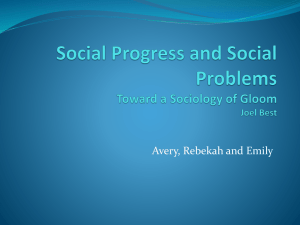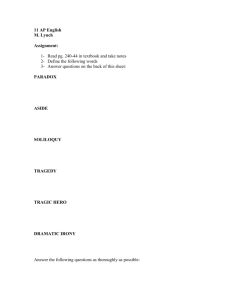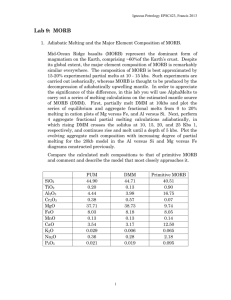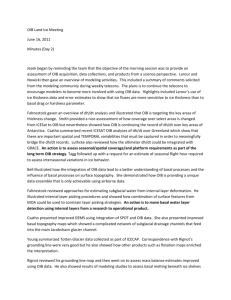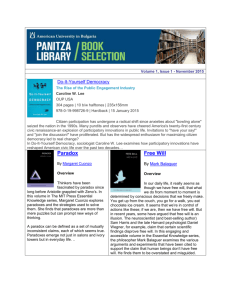presentation file
advertisement
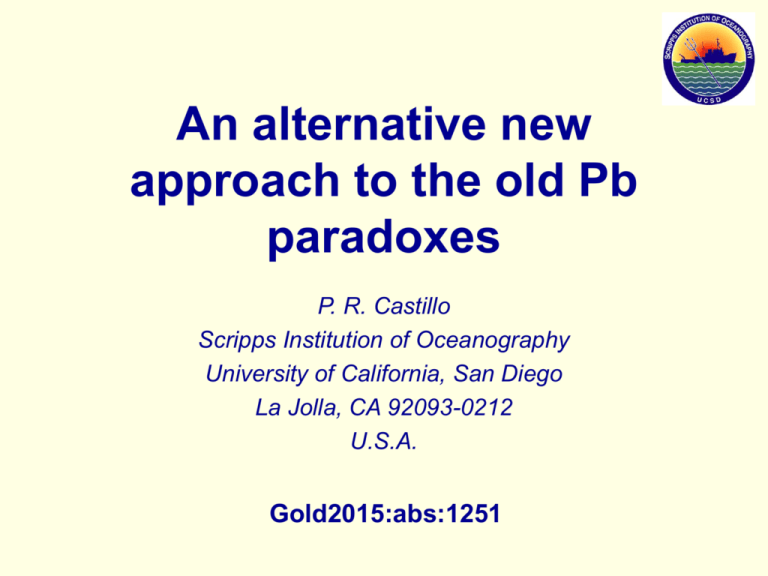
An alternative new approach to the old Pb paradoxes P. R. Castillo Scripps Institution of Oceanography University of California, San Diego La Jolla, CA 92093-0212 U.S.A. Gold2015:abs:1251 Oceanic basalts have radiogenic Pb isotopic ratios Allegre (2008) Increase in Pb isotopes a function of: 238U 206Pb 235U 207Pb 232Th 208Pb Thus, major concerns on the concentrations of U, Th and Pb in the mantle The Pb paradoxes 1st : long time-integrated high U/Pb 2nd : long time-integrated low Th/U 3rd : constant (’canonical’) Ce/Pb & Nb/U The Pb paradoxes Proposed significant solutions (~40 yrs): 1st : long time-integrated high U/Pb - lose Pb o into core - Allegre et al. (1982) o into cont. lithosphere/crust – Zartman & Haines (1988) o o 2nd : long time-integrated low Th/U Chauvel et al. (1992) into sulfide – Hart & Gaetani (2006) from early depleted reservoir (EDR)– Jackson et al. (2010) - increase U relative to Th Tatsumoto (1978); Galer and O’Nions (1985); Elliot et al. (1999) 3rd : constant (’canonical’) Ce/Pb & Nb/U - two major ways: o mantle re-homogenization – Hofmann et al. (1986) o changing Kd’s for Ce or Pb – Simms & DePaolo (1997) 2nd Pb paradox • Conventional approach – Th/U (or k = 232Th/238U) lower than BSE 2nd Pb paradox • Conventional approach – Th/U (or k = 232Th/238U) lower than BSE e.g., Tatsumoto (1978) Galer and O’Nions (1985) Elliot et al. (1999) • But it can also be expressed as - U/Th ( or 1/k non-conventional) higher than BSE i.e., long time-integrated high U/Th • Thus, 1st and 2nd paradoxes can be solved through long time-integrated U enrichment ! long time-integrated enrichment in U Important implications: 1st : long time-integrated high U/Pb o simultaneous solution to 1st and 2nd paradoxes o produces Pb* - hence, radiogenic Pb isotopes 2nd : long time-integrated low Th/U o inconsistent with proposed solutions to 3rd paradox (conservation of mass !) 3rd : constant (’canonical’) Ce/Pb & Nb/U o for MORB at least, Th/U is ‘constant’ 2nd Pb paradox • Conventional approach – Th/U (or k = 232Th/238U) lower than BSE (= 3.88) Th/U of MORB (at ~3.1) “remarkably homogeneous” (Elliot et al., 1999) 2nd Pb paradox • Conventional approach – Th/U (or k = 232Th/238U) lower than BSE (= 3.88) Th/U of MORB (at ~3.1) “remarkably homogeneous” (Elliot et al., 1999) • Later studies Arevalo & McDonough (2010) Jenner & O’Neil (2012) Gale et al. (2013) Th/U of (ALL) MORB 2.87+/- 1.35 3.16+/- 0.60 3.16+/- 0.11 • Thus, Th/U of MORB is also “constant” • (Th/U of OIB is only between 3.16 and 3.88 !) If Ce/Pb, Nb/U and Th/U constant (in MORB, at least) (Ratio of constants is also constant) • K1 = (Ce/Pb) / (Th/U) = (U/Pb) * ( Ce/Th) • K2 = (Ce/Pb) / (Nb/U) = (U/Pb) * (Ce/Nb) • K3 = (Th/U) / (Nb/U) = (Th/Nb) Trivial ? = Yes, but important because these also show close relationships among Pb paradoxes More relevant question = why are Ce/Pb, Nb/U, Th/U, Th/Nb constant? Castillo (submitted) Basic principle – two component mixing in a binary element plot generates a line, y = mx + b OIB (Willbold & Stracke, 2010) - Binary mixing line is special when b = 0, making y/x = m (= constant) - in Ce vs. Nb plot (MORB – Gale et al., 2013), mixing between enriched OIB and DMM generates a line with b ~ 0, hence Ce/Pb ‘constant’ DMM (Workman & Hart, 2005) Lucky ? – perhaps….. Castillo (submitted) Nb vs. U, Th vs. Nb (& Th vs. U) plots of MORB (Gale et al., 2013) OIB (Willbold & Stracke, 2010) DMM (Workman & Hart, 2005) • 1) mixing OIB + DMM also generates binary mixing lines with b ~ 0 in Nb vs. U, Th vs. Nb (& U vs Th) plots • Other methods: 2) by finding average ratios (b = 0) 3) Least-squares method (b ~0) OIB (Willbold & Stracke, 2010) • All methods produce the ~same (+/- errors) constant (‘canonical’) ratios DMM (Workman & Hart, 2005) Castillo (submitted) Summary and conclusions • The radiogenic Pb isotopes of oceanic basalts create the Pb paradoxes – many excellent solutions proposed, but mainly individualized • Paradoxes are inter-related, comprising a “system of equations” that should be solved altogether or simultaneously as solution to each equation should also be consistent to solutions to other equations • Systems of equations require linear or non-linear solutions. Pb paradoxes can be simply solved through linear, binary mixing solutions Castillo (submitted) A conceptual model MORB: binary mixing (enriched melt + DMM) OIB: binary mixing (end-members + FOZO) Modified after Castillo (2015) Castillo (submitted) subduction of a small amount of marine limestone (natural HIMU) is required some limestone are being subducted and not being consumed by arc magmatism

